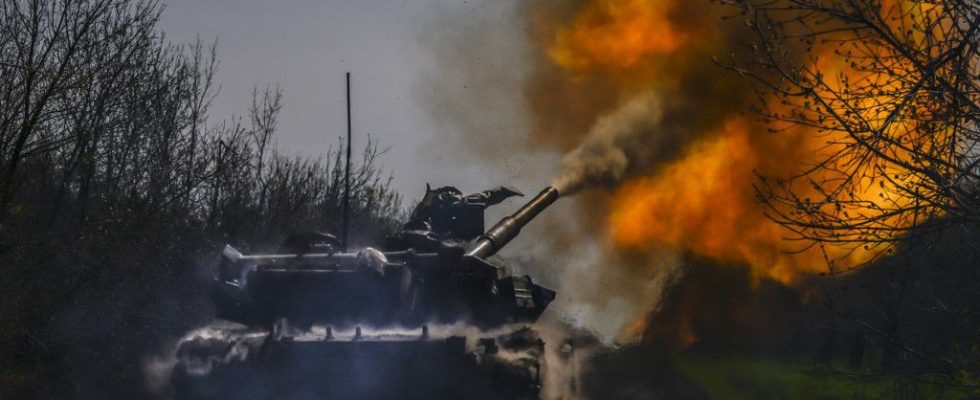Like an atmosphere of arms vigil on the Ukrainian front. Pending the counter-offensive by Kiev forces announced for this spring, strikes and sabotage actions against Russian logistics centers and depots have multiplied in recent weeks both in Russia and in the occupied territories. “In terms of military strategy, it’s a great classic, points out General Dominique Trinquand, military expert and former head of the French mission to the UN. The objective of these actions is to ‘shape the terrain’ in order to make it more favorable to the Ukrainian forces.”
Images of Russian fuel depots going up in smoke – already common before the previous counter-offensive, at the end of August 2022 – made their sudden comeback. On May 5, an oil refinery suffered a fire following a drone attack in Ilsky in Russia’s Krasnodar region. The day before, a first explosion had already shaken this same installation, while another refinery caught fire in the Russian region of Rostov. On May 2, finally, another oil site was ravaged by flames in Volna, near annexed Crimea, only three days after a gigantic fire in a fuel depot in Sevastopol, the main base of the Russian fleet of the sea. Black.
Limit the enemy’s ability to react
“Targeting the fuel or ammunition depots will make it possible to hinder the supply of the Russian forces, resumes General Trinquand. At the time of the Ukrainian offensive, this will de facto limit their ability to react.” Russian energy installations are not the only targets. Meanwhile, explosions derailed two Russian freight trains on May 1 and 2 in the Bryansk region bordering Ukraine. A high-voltage line was also damaged in early May by an explosive device in the Leningrad region.
“The Kiev regime, which is behind a number of these attacks and bombings, plans to continue along this line,” Kremlin spokesman Dmitry Peskov denounced in early May, assuring that the Russian intelligence services would do “whatever is necessary to ensure safety”. The accumulation of these attacks is crucial for the future. “Despite its difficulties on the front, Russia is indeed still capable of supporting the major war effort that this conflict represents, points out Mathieu Boulègue, associate researcher at Chatham House. Ukrainian forces to further destabilize the enemy organization.”
deceive the opponent
Beyond these attacks, the Ukrainian forces have every interest in maintaining vagueness on the main axis of attack that they will choose to carry out their counter-offensive. And put into practice maneuvers of “deception”, intended to deceive the adversary. “In concrete terms, it is a question of making people believe in an offensive on a given point, but in reality leading the bulk of the attack on another, details Mathieu Boulègue. By wrongly reinforcing certain parts of the front that he believes are threatened , the enemy may have to strip others which will therefore be easier to pierce. A way for Ukraine to maximize its chances of success, as the Russians have been careful to strengthen their defenses in recent months, lining up tens of thousands of mines and dragons teeth, these concrete cones intended to hinder progress armour, in addition to hundreds of kilometers of trenches dug along the front line.
While many observers have been waiting for several months for a Ukrainian breakthrough in the direction of Melitopol – in order to cut the Russian force in southern Ukraine in two – the Ukrainian general staff could also opt for a more unexpected solution. A strategy already implemented during the previous counter-offensive in the summer of 2022. “The Ukrainian forces had insisted a lot on their desire to retake Kherson, recalls Thibault Fouillet, researcher at the Foundation for Strategic Research (FRS). But in parallel, they had also prepared a counter-attack in the Kharkiv region which resulted in a dazzling breakthrough.”
Will the Ukrainian forces reuse the same tactic? Already, the Russian occupation authorities announced on May 5 the evacuation of 70,000 people from 18 localities in the Zaporizhia region in the face of “increased bombardments”. In parallel, Kyiv forces allegedly advanced, according to the Ukrainian army, almost three kilometers southwest of Bakhmout on May 9, inflicting heavy casualties on the 72nd Motorized Rifle Brigade and Wagner’s forces. “The whole challenge for the Ukrainian forces is to manage to model an area of operations to their advantage, while camouflaging this action in a more global effort, summarizes Thibault Fouillet. The idea being not to target a single point of way too visibly, so as not to reveal their main line of effort.” And thus maintain the element of surprise.
